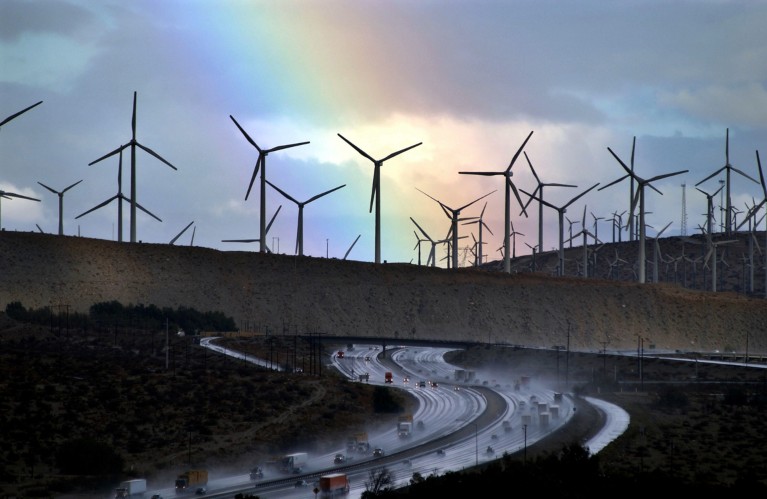Emissions – the ‘business as usual’ story is misleading
- COMMENT
- 29 January 2020
Stop using the worst-case scenario for climate warming as the most likely outcome — more-realistic baselines make for better policy.
By
- Zeke Hausfather 1. Zeke Hausfather is director of climate and energy at the Breakthrough Institute, Oakland, California, USA.
- Glen P. Peters 1. Glen P. Peters is research director at the CICERO Center for International Climate Research, Oslo, Norway.

Falling costs for generating clean electricity have led to a proliferation of wind farms, such as this one near Palm Springs, California. Credit: David McNew/Getty
More than a decade ago, climate scientists and energy modellers made a choice about how to describe the effects of emissions on Earth’s future climate. That choice has had unintended consequences which today are hotly debated. With the Sixth Assessment Report (AR6) from the Intergovernmental Panel on Climate Change (IPCC) moving into its final stages in 2020, there is now a rare opportunity to reboot.
Access options
Access Nature and 54 other Nature Portfolio journals
Get Nature+, our best-value online-access subscription
24,99 € / 30 days
cancel any time
Subscribe to this journal
Receive 51 print issues and online access
199,00 € per year
only 3,90 € per issue
Rent or buy this article
Prices vary by article type
from$1.95
to$39.95
Prices may be subject to local taxes which are calculated during checkout
Additional access options:
Nature 577, 618-620 (2020)
doi: https://doi.org/10.1038/d41586-020-00177-3
References
Moss, R. H. et al. Nature 463, 747–756 (2010).
Riahi, K. et al. Climat. Change 109, 33 (2011).
van Vuuren, D. P. et al. Climat. Change 109, 5 (2011).
Pörtner, H.-O. et al. (eds) IPCC Special Report on the Ocean and Cryosphere in a Changing Climate (IPCC, 2019).
Ho, E., Budescu, D. V, Bosetti, V., van Vuuren, D. P. & Keller, K. Climat. Change 155, 545–561 (2019).
Ritchie, J. & Dowlatabadi, H. Energy Econ. 65, 16–31 (2017).
International Energy Agency. World Energy Outlook 2019 (IEA, 2019).
Rogelj, J. et al. Nature 534, 631–639 (2016).
Friedlingstein, P. et al. J. Clim. 27, 511–526 (2014).
Lenton, T. M. et al. Nature 575, 592–595 (2019).
Peters, G. P. et al. Nature Clim. Change 3, 4–6 (2013).
O’Neill, B. C. et al. Geosci. Model Dev. 9, 3461–3482 (2016).
Intergovernmental Panel on Climate Change. Global Warming of 1.5 °C (IPCC, 2018).
Weber, C. et al. Nature Clim. Change 8, 845–848 (2018).
United Nations Environment Programme. Emissions Gap Report 2018 (UN, 2019).
King, D., Schrag, D., Dadi, Z., Ye, Q. & Ghosh, A. Climate Change: A Risk Assessment (Univ. Cambridge, 2015).
Morgan, M. G. & Keith, D. W. Climat. Change 90, 189–215 (2008).
Tàbara, J. D., St. Clair, A. L. & Hermansen, E. A. T. Environ. Sci. Pol. 70, 31–37 (2017).
Riahi, K. et al. Glob. Environ. Change 42, 153–168 (2017).
van Ruijven, B. J. Clim. Change 138, 361–367 (2016).
Related Articles
[

The hard truths of climate change — by the numbers](https://www.nature.com/immersive/d41586-019-02711-4)[

Climate talks must chart an equitable path to net-zero emissions](https://www.nature.com/articles/d41586-019-03708-9)[

A new scenario logic for the Paris Agreement long-term temperature goal](https://www.nature.com/articles/s41586-019-1541-4)
